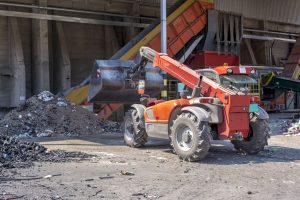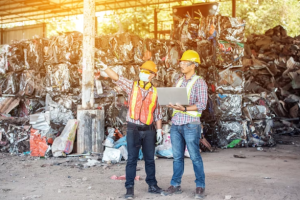Construction and Demolition (C&D) waste, also known as C&D debris or materials, is a type of waste generated from construction, renovation, repair, or demolition activities. C&D waste is usually made up of wood, concrete, steel masonry, gypsum, plaster, metal, and asphalt. Research indicates that C&D wastes account for 30% of total waste produced globally, and it is estimated that 35% of all C&D waste ends up in landfills annually.
C&D waste is a serious matter because it has significant environmental impacts such as land space consumption, landfill depletion, energy and non-energy resource consumption, resource depletion, air pollution, soil pollution, water pollution, etc. C&D waste also contains hazardous materials such as asbestos and lead which can cause human health problems.
Because of these risks, it is important to learn how to manage C&D wastes. In this article, we will discuss how to properly reduce, reuse, recycle, and dispose of C&D waste.
Best Practices for Construction & Demolition Waste Management
Reduce waste

One of the best ways to manage C&D waste is to reduce its generation. C&D waste reduction can be achieved by using eco-friendly and sustainable construction materials, minimizing scrap generated during construction or demolition activities, and efficiently planning the construction process to reduce waste.
You can also check out our article on the 10 sustainable construction materials in the Philippines for reference.
Reuse materials
Before disposing of any materials, consider whether we can reuse them. Non-hazardous materials like wood, bricks, steel, metals, etc. can be salvaged and reused for future projects. Donating these materials to other organizations for their use is also a viable option.
Recycle materials

Non-hazardous C&D materials can be recycled to help reduce waste and conserve natural resources. Wood, concrete, bricks, masonry, asphalt, and metal can still be reprocessed to create other materials or items.
Consider partnering with a local recycling facility to properly manage C&D waste.
Proper disposal
![]()
Source: Recycling Magazine
Not all C&D waste materials can be reused or recycled. Items such as lead, asbestos, stripping paint, aerosol cans, solvents, insulation, etc. are non-recyclable hazardous materials and must be disposed of properly to avoid damage to the environment and human health.
Follow local regulations for disposing of C&D waste. For more information, you can refer to this announcement from the Environmental Management Bureau.
Education and Training

Proper management of C&D materials requires the education and training of different professionals involved in the project. Ensure that construction workers, contractors, and project managers are well aware of proper waste management practices and have access to the resources necessary to implement them.
Benefits of Construction and Demolition Waste Management
Reducing the amount of C&D waste is beneficial for the construction industry, the environment, and society. Benefits of proper C&D waste management include:
• Construction firms can benefit from reduced overall expenses by slashing or avoiding disposal costs.
• Donation of unused construction materials to the government or non-government organizations may provide tax exemptions as per the Tax Code of the Philippines.
• Reduced pollution and environmental damage.
• Reduce environmental damage associated with disposal facilities.
• Reduction of hazardous materials that can cause harm to human health.
• Helps in reducing natural resource extraction and consumption.
• Create employment and economic activities in the recycling industries and increase business opportunities within the local community.
Overall, proper C&D waste management can lead to sustainability and open up new economic opportunities while also reducing negative environmental impacts.
Construction and demolition waste management is a crucial practice for reducing environmental impacts and protecting human health. With C&D waste accounting for a significant percentage of total waste produced globally and containing hazardous materials, it is important to implement best practices for reducing, reusing, recycling, and disposing of these materials. By following these practices, we can help conserve resources, reduce pollution, and create a more sustainable for future generations.
References:
- Purchase, C. K., Zulayq, D. M. A., O’Brien, B. J., Kowalewski, M. G., Berenjian, A., Tarighaleslami, A. H., & Seifan, M. (2021). Circular Economy of Construction and Demolition Waste: A Literature Review on Lessons, Challenges, and Benefits. Materials, 15(1), 76. https://doi.org/10.3390/ma15010076
- Chen, K., Wang, J., Yu, B., Wu, H., & Zhang, J. (2021). Critical evaluation of construction and demolition waste and associated environmental impacts: A scientometric analysis. Journal of Cleaner Production, 287, 125071. https://doi.org/10.1016/j.jclepro.2020.125071
- Construction and Demolition Debris: Material-Specific Data | US EPA. (2022, December 3). US EPA. https://www.epa.gov/facts-and-figures-about-materials-waste-and-recycling/construction-and-demolition-debris-material#:~:text=Construction%20and%20Demolition%20(C%26D)%20debris%20is%20a%20type%20of%20waste,%2C%20concrete%2C%20and%20asphalt%20concrete.
- Construction and Demolition Debris: Material-Specific Data | US EPA. (2022c, December 3). US EPA. https://www.epa.gov/facts-and-figures-about-materials-waste-and-recycling/construction-and-demolition-debris-material#:~:text=Construction%20and%20Demolition%20(C%26D)%20debris%20is%20a%20type%20of%20waste,%2C%20concrete%2C%20and%20asphalt%20concrete.
- What is CD Waste. (n.d.). CT.gov – Connecticut’s Official State Website. https://portal.ct.gov/DEEP/Waste-Management-and-Disposal/Construction-and-Demolition-Waste/What-is-CD-Waste
- Kinematics, G. (2017, May 10). C&D Waste Recycling – What Materials Are Included? General Kinematics. https://www.generalkinematics.com/blog/cd-waste-recycling-materials-included/
- Recycling of Construction & Demolition (C & D) Materials. (2022, November 10). https://www.cedd.gov.hk/eng/public-services-forms/fill-management/recycling-of-construction-demolition-c-d-materials/index.html



